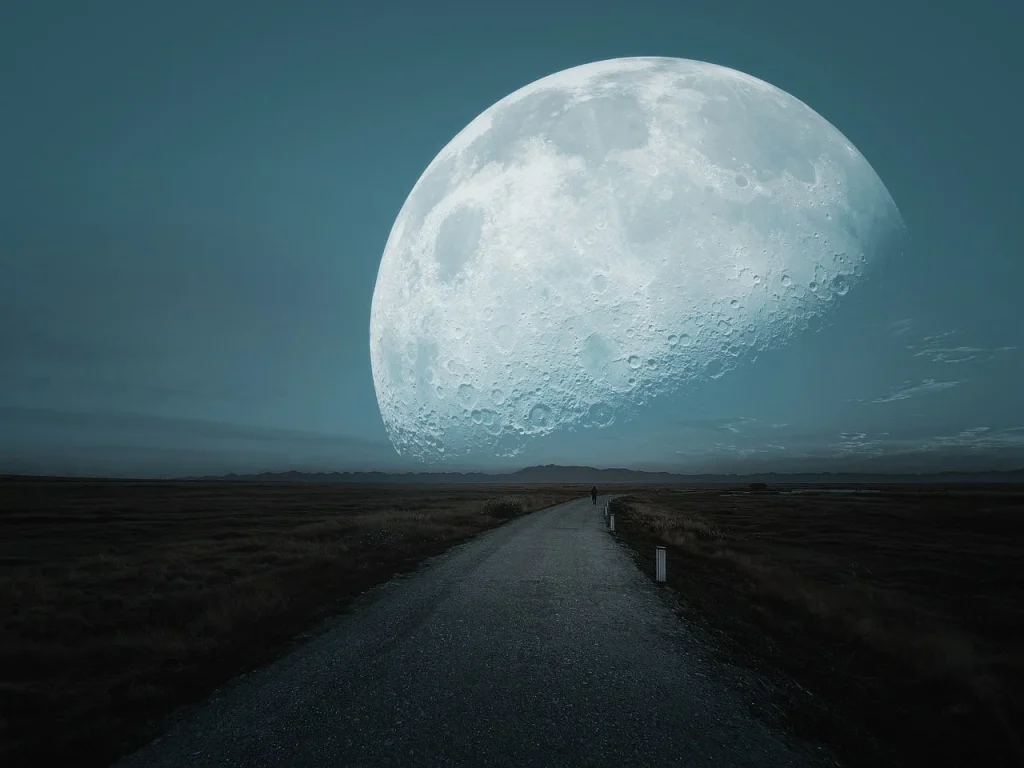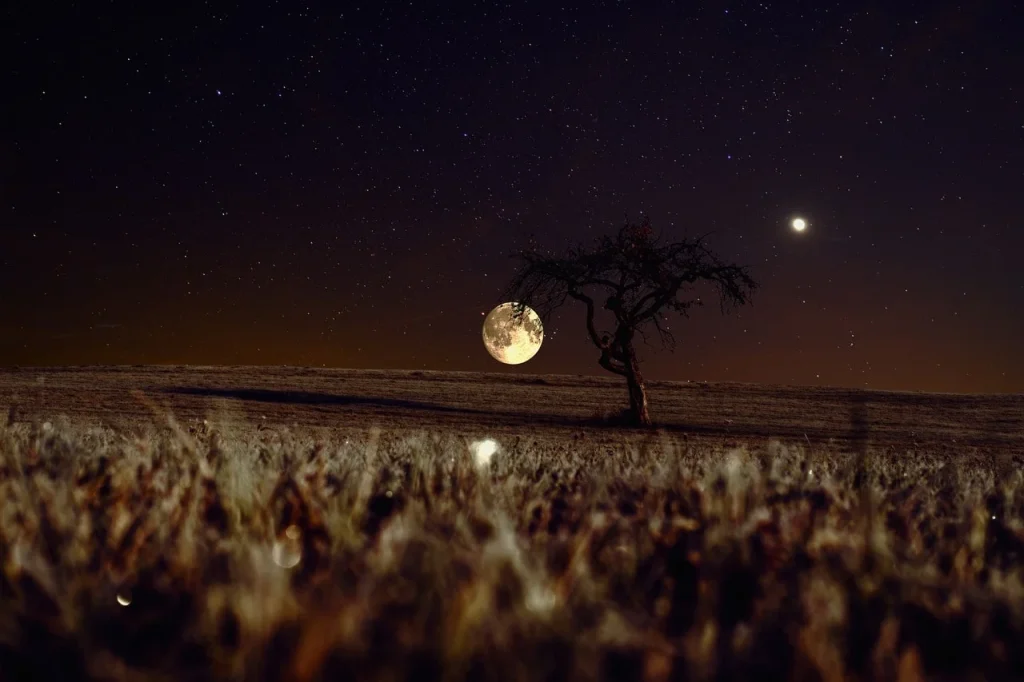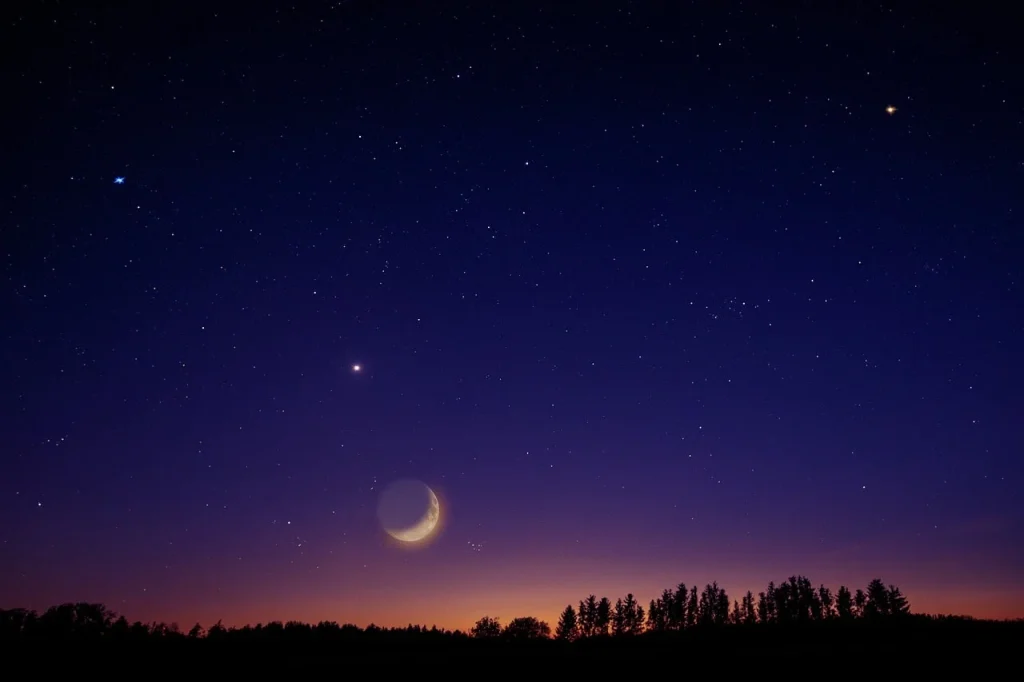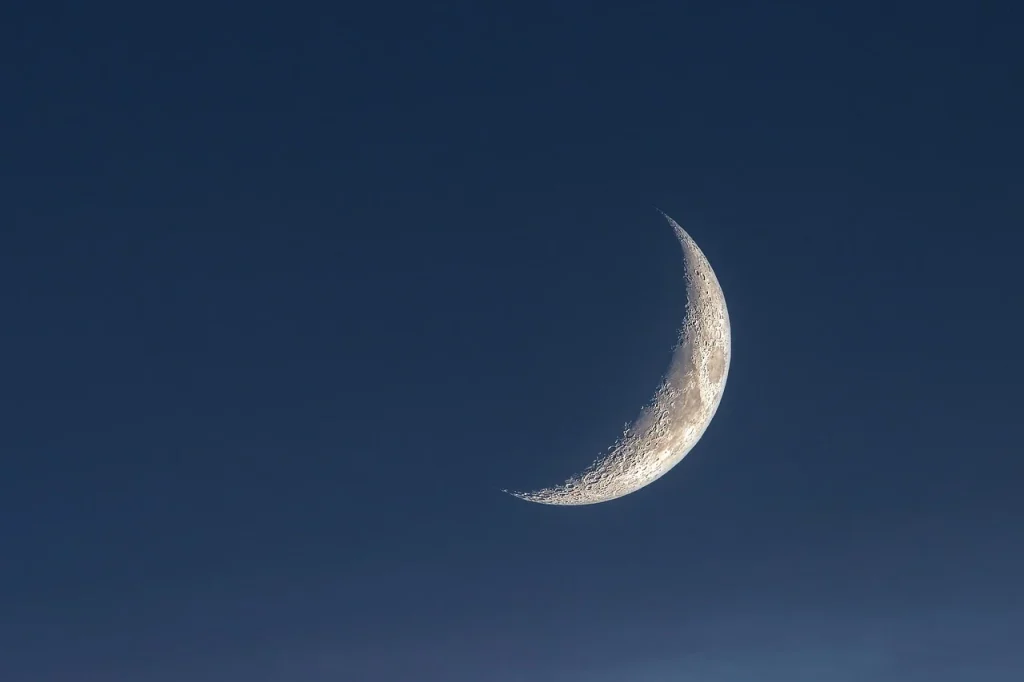Let’s kick things off with a light-hearted question: What does the moon do when it gets tired? It goes through its phases!
All jokes aside, the moon is more than just a pretty face in our night sky. It influences our planet in countless ways, from guiding sea turtles back to their birthplace to affecting how we feel.
In this blog, we’ll explore some fun facts about the moon that will illuminate your mind and tickle your curiosity. Curious to know which fact will surprise you the most? Let’s start.
The moon is a friend for the lonesome to talk to.
Carl Sandburg
Moon Facts
Dive into the mysteries of the moon! As you explore the facts ahead, keep in mind that there’s a quiz waiting at the bottom of this article. Read carefully to prove your expertise on our lunar companion.
- The temperature on its surface can plummet to minus 173 degrees Celsius during the night.
- Its gravitational force is only 17% of Earth’s, affecting the muscles and bone density of astronauts.
- Helium-3, an isotope potentially usable for nuclear fusion, is abundant in its soil.
- It is moving away from Earth at a rate of approximately 3.8 cm per year.
- The lunar atmosphere contains trace amounts of neon, hydrogen, and helium.
- Water ice exists in the shadowed craters at its poles.
- The oldest rocks on its surface are thought to be about 4.5 billion years old.
- It has its own set of moonquakes, caused by gravitational pulls from Earth.
- Earth and the Moon have synchronous rotations, meaning we only see one side from our planet.
- No significant magnetic field protects it from cosmic and solar radiation.
- The crust on its far side is much thicker than the one facing Earth.
- Colonization plans by various nations target its south pole due to water availability.
- Rust has been found on its surface, despite the lack of oxygen and water.

- During the lunar day, surface temperatures can reach up to 127 degrees Celsius.
- Its presence helps stabilize Earth’s axis and climate.
- Regolith, or lunar soil, is composed of fine dust and rocky debris.
- The lowest point in its topography is the Aitken Basin, deeper than Earth’s Mariana Trench.
- It possesses its own bridges, arches, and other natural stone formations.
- Neil Armstrong used his finger to adjust a broken circuit switch, crucial to the Apollo 11’s safe return.
- Its orbit is not a perfect circle but rather an elliptical shape.
- Solar winds can directly hit the surface, altering the soil chemistry.
- Only 12 people have ever walked on its surface, all Americans.
- Seismic activities there last significantly longer than earthquakes due to the lack of water in the mantle.
- The visible surface is covered with thousands of impact craters.
- Tidal forces between Earth and the Moon cause the ocean tides on our planet.
- Apollo 12 astronauts brought back equipment from the previously landed Surveyor 3 mission.
- Its polar regions are considered some of the coldest places in the solar system.
- There are no active volcanoes on its surface today, but there were in the distant past.

- Surface explorations have yielded over 382 kilograms of rocks and soil to Earth.
- The first soft landing was achieved by the Soviet spacecraft Luna 9 in 1966.
- Footprints and rover tracks left by astronauts could remain intact for millions of years due to the lack of wind and water.
- It is the fifth largest natural satellite in the solar system.
- The concept of moon gardening is based on its phases influencing plant growth cycles.
- During a total lunar eclipse, it can appear red due to Earth’s atmosphere scattering sunlight.
- Lunar orbiters have mapped almost 100% of its surface.
- It has a potential subsurface ocean beneath its icy crust, according to some scientists.
- Microenvironments on its surface might support transient liquid water.
- A phenomenon known as lunar libration allows us to see up to 59% of its surface from Earth over time.

- The giant-impact hypothesis suggests it was formed after a Mars-sized body collided with Earth.
- Known as the Lunar Swirls, some areas on its surface are mysteriously brighter and less weathered.
- Ancient cultures have used its cycles to develop calendars and mark time.
- It is the only other celestial body where humans have placed a mirror to reflect lasers for Earth-based experiments.
- The Shackleton Crater, near the south pole, is a key exploration target for future missions.
- Experiments have shown that plants can grow in lunar soil, which is crucial for long-term habitation.
- The term selenography is used to describe the study of its surface and physical features.
- Apollo missions have left an array of scientific instruments, including seismometers and heat flow probes.
- It has no global geological activity, such as plate tectonics, like Earth does.
- Its existence could have shielded Earth from some meteor impacts, potentially altering the course of life on our planet.
- Despite its lifeless appearance, some believe it could harbor extremophiles in sheltered areas.
- Global interest in returning to the Moon has surged, with multiple countries and private companies planning missions.
Moon Myths

Now that you’re armed with some cool facts about the moon, let’s continue with a different realm: myths. In this section, we’ll sift through popular moon myths and shine a light on what’s true and what’s merely lunar lore.
- The Moon Has a Dark Side
In common discourse, it is often said that a “dark side” of the moon exists, perpetually hidden from Earth’s view. However, all parts of the moon are illuminated by the sun at different times. What is true is that one hemisphere of the moon always faces away from Earth due to tidal locking. - The Full Moon Affects Human Behavior
Despite popular belief, no conclusive evidence has been found that links the full moon to erratic human behavior. Studies conducted over the years have consistently debunked the idea that the lunar cycle has a significant impact on psychological outcomes. - The Moon’s Gravity Causes Earthquakes
It is a common misconception that the moon’s gravitational pull is strong enough to cause earthquakes. While tides on Earth are indeed influenced by lunar gravity, the forces exerted are not powerful enough to directly initiate seismic activity. - Supermoons Are Dramatically Larger and Brighter
The term “supermoon” might suggest a profound change, but in reality, supermoons are only slightly larger and brighter than the average full moon. This slight increase is often not noticeable to the casual observer without comparative measurement tools. - The Moon Landing Was Staged
A persistent myth is that the Apollo moon landings were fabricated and not genuine. Extensive evidence and eyewitness accounts from hundreds of thousands of people involved in the mission confirm that the landings were indeed conducted on the moon’s surface.
No products found.
Moon Quotes

Let’s explore what some popular figures have said about Earth’s celestial companion through a collection of inspiring quotes.
The moon puts on an elegant show, different every time in shape, colour and nuance.
Arthur C. Clarke
Arthur C. Clarke, a visionary science fiction writer, emphasized the ever-changing beauty of the moon, highlighting its constant transformation and the unique spectacle it offers.
We are all like the bright moon, we still have our darker side.
Khalil Gibran
Khalil Gibran, a poet and philosopher, drew a parallel between human nature and the moon, noting that just as the moon has a dark side it does not reveal, so do people harbor unseen aspects of their personalities.
Shoot for the moon. Even if you miss, you’ll land among the stars.
Norman Vincent Peale
Norman Vincent Peale, known for his emphasis on positive thinking, used this quote to inspire ambition and perseverance, suggesting that aiming high, even if not fully achieved, leads to great outcomes.
The moon is the reflection of your heart and moonlight is the twinkle of your love.
Debasish Mridha
Debasish Mridha, a philosopher and author, reflects on the romantic and personal connection people feel with the moon, metaphorically linking it to human emotions and love.
Yours is the light by which my spirit’s born: – you are my sun, my moon, and all my stars.
E.E. Cummings
E.E. Cummings, in his unique poetic style, expresses deep affection and adoration, elevating the loved one to the status of the entire cosmos, which is essential for his existence and inspiration.
Moon FAQ

Next, we continue with some frequently asked questions about the moon. This section is crucial, as it’s the final one before your quiz, so pay close attention to each answer.
- Why does the moon look bigger sometimes?
It can appear larger due to an optical illusion when it’s closer to the horizon. Objects in the foreground, like buildings or trees, give our brain contextual clues, making the moon seem relatively larger than when it is higher in the sky. - How was the moon formed?
The most widely accepted theory is that it was formed from the debris left over after a massive object about the size of Mars collided with Earth. This event, occurring over 4.5 billion years ago, created a disk of material that eventually coalesced into the Moon. - Can the moon crash into Earth?
No, it won’t crash into Earth. In fact, the Moon is slowly moving away from Earth, at about 3.8 centimeters (1.5 inches) per year. This gradual distance increase ensures that the moon remains a steadfast companion in our sky. - Why does the moon change shape?
It doesn’t actually change shape, but our view of it changes. This phenomenon, known as the lunar phase, occurs because the Moon orbits the Earth, and we see varying amounts of sunlight reflected off the Moon’s surface depending on its position relative to Earth and the Sun. - Can the moon be seen during the day?
Yes, it can often be seen during the day. This visibility largely depends on its phase; a full moon is only visible at night, but at other times of the month, especially when it is less than full, the moon can be seen in the daytime sky.
No products found.
Moon Trivia

Get ready for a lunar quiz that’s truly out of this world! Be warned, if you miss all the questions, you might just find yourself stuck orbiting in confusion!
Conclusion
Through this article, we’ve uncovered fascinating insights about the moon, each fact a reminder of its impact on our daily lives and its importance in the broader universe.
From its formation to its phases and influence on Earth, the moon continues to inspire and intrigue. It’s a constant companion that encourages us to look upward and dream bigger.
Let’s finish this one with a funny question: If moon dust smelled like anything, what scent would you want it to be? Let me know in the comments.
2 Sources Used For This Article

